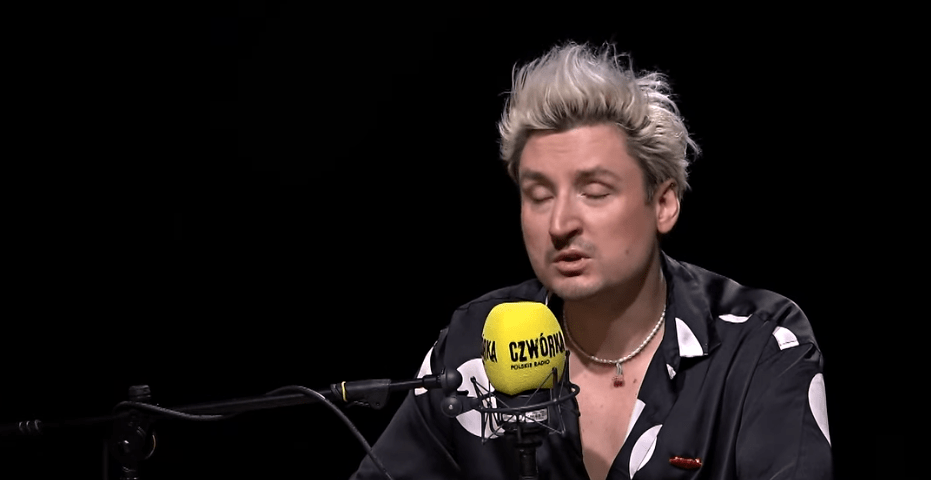Filip Cembala transmits as well as performs. He seems to place every look, pause, and word he says like a handwritten note left on a stranger’s doorstep. He has become one of Poland’s most emotionally charged artists in recent years, capturing audiences’ attention and making them feel not only as characters but also as themselves. His performances, particularly those he did with the late Joanna Kołaczkowska, have come to represent a nation grappling with joy, loss, and belonging.
Cembala’s development as an artist has been incredibly natural. He began his career in notably traditional roles in television classics like Plebania, Na Wspólnej, and Na dobre i na złe. Despite being measured, these performances helped him hone his emotional realism instincts. His move from regulated television to the unrestricted platform of social media felt especially novel since it gave him the opportunity to experiment with more absurdist and philosophical aspects of his voice.
Cembala’s collaboration with Joanna Kołaczkowska, a legendary figure in Polish comedy, opened up a new creative era. In sketches like “To nie jest traktor” and “Przebacz,” their chemistry was remarkably similar to that of famous duos like Tina Fey and Amy Poehler. However, theirs was made even more intimate by the fact that Kołaczkowska lovingly called Cembala her “siostrzeniec,” a lighthearted term that reflected their special relationship.
Biographical Table
| Full Name | Filip Cembala |
|---|---|
| Date of Birth | 1986 |
| Nationality | Polish |
| Profession | Actor, Vocalist, Digital Creator, Author |
| Known For | Plebania, Na Wspólnej, Na dobre i na złe |
| Stage Affiliation | Teatr Polski in Szczecin since 2011 |
| Social Media | Instagram: @itsmefilipce (171K+ followers) |
| Books | Lowizm czyli na szlaku po ulgę |
| Music | Lowizm, KolęDUSZKA |
| Creative Movement | Founder of “Lowizm” |
| Collaborator | Joanna Kołaczkowska (deceased) |
| Official IMDb | IMDb Profile |

Cembala’s humorous videos became therapeutically significant during the pandemic and its emotionally taxing aftermath. They were able to express grace and humor through improvisation. Because it felt human, rather than because it went viral, “Przebacz,” which received over eight million views, became a cultural phenomenon. In less than 60 seconds, it encapsulated the essence of shared experience—the way we argue and forgive.
The nation has been grieving Kołaczkowska’s passing for a few weeks. After a protracted fight with cancer, she passed away at the age of 59. Although the effect was felt by many, those who had relied on the two artists’ videos for solace were particularly affected. Cembala’s tribute was a statement of appreciation, sorrow, and emotional inheritance rather than merely a farewell. He shared a video montage that featured a quiet moment in which she whispers, “Prowadź się dobrze, Filip,” as though she were passing on her soul as well as her humor.
Both critics and viewers found this tribute to be especially poignant. The words “Są ludzie niezastąpieni… narodowa dilerko radości,” which Cembala wrote in his post, have been reverberating on social media like a candlelight vigil. His message, which was based on love, humility, and an agonizing honesty, was very clear and not at all theatrical.
Lowizm, a term that started out as an abstract idea but has since developed into an emotional philosophy, is the focus of Cembala’s creative energies during the past 12 months. Lowizm encourages people to look for gentle relief from internal weight, such as sadness, fear, or exhaustion, in the context of emotional wellness. Cembala gives feelings that most people avoid naming a poetic shape through songs like Tarcza I Miecz and KolęDUSZKA. He has greatly lowered the distance between performer and audience by doing this.
Cembala’s message has reached younger audiences by strategically utilizing short-form video platforms such as Facebook, YouTube, and TikTok. Many of these audiences find traditional therapy intimidating or unattainable. His material, which is frequently presented in a gentle and ridiculous manner, functions as a daily supplement for emotional fortitude.
His writing is thoughtful, cautious, and incredibly powerful; it reads like a quiet conversation at midnight, especially in his book Lowizm czyli na szlaku po ulgę. Like a breeze cooling your skin while reminding you that it’s still warm outside, readers and listeners describe the experience as both reassuring and energizing.
“twórca #lowizmu i @slowosiemnabawi” is all that is written in Filip’s Instagram bio. This subtle statement highlights his continued work, which includes joint podcasts and live performances, particularly with platforms like Pierwsza randka. He provides a window into a reality that has been tempered by lived emotion and softened by awareness in each appearance.
Cembala’s strategy seems especially radical in the entertainment sector, where rapid consumption frequently takes the place of deliberate art. Despite their emotional depth, his performances are anchored in grace and humor. In many respects, he is reiterating a more general trend toward authenticity, one that has been forged by artists such as Michał Szpak and broadened by socially conscious producers like Dawid Podsiadło.
Cembala has used digital platforms to spread messages that are very trustworthy for people who are trying to find peace. Additionally, he teaches others how to grieve gracefully while also grieving in public. He is subtly creating a legacy through his work that is grounded in emotional resonance rather than celebrity. He is pursuing connection rather than numbers.
As Poland’s entertainment scene shifts toward digitalization in the upcoming years, Cembala is positioned to emerge as a calming force amidst the deluge of content. His journey serves as a reminder that art can still be a healing force in the face of suffering and that candid laughter can be especially helpful in a society recovering from its collective weariness.

